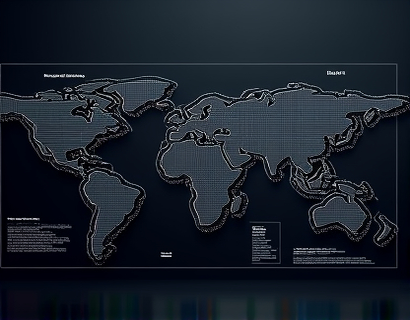Advanced Software for Graph Theory and Fluid Dynamics: Empowering Insights for Complex System Analysis
In the realm of complex system analysis, the integration of advanced software solutions for graph theory and fluid dynamics has revolutionized the way researchers and engineers approach intricate problems. These sophisticated tools are designed to streamline complex data analysis, enhance visualization, and drive innovative discoveries in mathematical modeling and fluid mechanics. For professionals in these fields, the availability of precise analysis and unparalleled insights provided by these tools is invaluable, facilitating groundbreaking advancements and performance optimization.
Graph Theory Software: A Tool for Network Analysis
Graph theory, a branch of mathematics that studies the properties of graphs, is pivotal in understanding and analyzing networks. In various domains such as computer science, biology, and social sciences, networks are represented as graphs where nodes symbolize entities and edges represent relationships. Advanced software for graph theory enables researchers to model, analyze, and visualize these networks with high precision.
One of the key features of these software solutions is their ability to handle large and complex networks efficiently. Algorithms for shortest path, minimum spanning trees, and network flow are implemented with optimization techniques ensuring rapid computation even for massive datasets. This capability is crucial for applications like traffic routing, social network analysis, and biological network modeling where speed and accuracy are paramount.
Moreover, these tools offer extensive visualization capabilities, allowing users to graphically represent networks and identify patterns, clusters, and anomalies. Interactive visualizations provide deeper insights into the structure and dynamics of networks, facilitating a better understanding of complex interactions and dependencies.
Fluid Dynamics Software: Simulating and Analyzing Fluid Behavior
Fluid dynamics, the study of fluids in motion, is essential for a wide range of applications including aerospace engineering, environmental science, and chemical engineering. Advanced software for fluid dynamics provides powerful simulation tools that model fluid behavior under various conditions, enabling researchers to predict and analyze complex phenomena.
These software solutions employ numerical methods such as finite element analysis and computational fluid dynamics (CFD) to solve the equations governing fluid flow, heat transfer, and mass transport. High-fidelity simulations allow for the detailed examination of flow patterns, pressure distributions, and turbulence, which are critical for designing efficient systems and optimizing performance.
One of the significant advantages of modern fluid dynamics software is its user-friendly interface and comprehensive feature set. Users can easily set up simulations, customize boundary conditions, and visualize results in real-time. This ease of use makes advanced fluid dynamics analysis accessible to a broader audience, including engineers and researchers without extensive computational expertise.
Integration of Graph Theory and Fluid Dynamics
The intersection of graph theory and fluid dynamics opens up new avenues for research and application. For instance, graph-based methods can be used to discretize fluid domains, simplifying the computational complexity of fluid dynamics simulations. Conversely, fluid dynamics principles can inform the design of networks and systems modeled using graph theory, leading to more robust and efficient solutions.
Advanced software that bridges these two fields offers integrated tools for multi-physics simulations, where both graph-theoretic and fluid dynamic models coexist and interact. This integration enables a holistic approach to system analysis, providing a more comprehensive understanding of complex phenomena.
Enhancing Data Analysis and Visualization
The ability to handle and visualize large datasets is a cornerstone of modern research in graph theory and fluid dynamics. Advanced software solutions excel in this area, offering robust data management and sophisticated visualization techniques.
Data management features include efficient data storage, fast data retrieval, and support for various data formats. These capabilities ensure that researchers can work with extensive datasets without performance bottlenecks. Additionally, advanced indexing and querying mechanisms allow for quick and precise data manipulation, which is essential for iterative analysis and experimentation.
Visualization is another critical aspect where these software tools shine. Interactive 3D visualizations, heat maps, and dynamic graphs provide intuitive and detailed representations of complex data. Users can explore different perspectives, zoom in on specific regions, and annotate visualizations for better interpretation. These features are particularly useful for identifying trends, anomalies, and correlations that might not be apparent from raw data.
Driving Innovative Discoveries
The precision and depth of analysis provided by advanced software for graph theory and fluid dynamics have led to numerous innovative discoveries. In graph theory, researchers have uncovered new properties of large networks, leading to advancements in areas such as epidemiology, where understanding the spread of diseases through social networks is crucial.
In fluid dynamics, simulations have enabled the design of more efficient aerodynamic shapes, improved heat exchangers, and optimized fluid transport systems. These advancements not only enhance performance but also reduce costs and environmental impact. The ability to simulate and analyze complex scenarios virtually saves time and resources, accelerating the development process.
Performance Optimization in Mathematical Modeling
Performance optimization is a key benefit of using advanced software in mathematical modeling. By leveraging high-performance computing (HPC) and parallel processing techniques, these tools can handle computationally intensive tasks with ease. This capability is particularly important for large-scale simulations in fluid dynamics, where the number of calculations can be in the billions.
Optimization algorithms within the software ensure that simulations run efficiently, minimizing computation time without compromising accuracy. This efficiency allows researchers to perform more extensive parameter studies and sensitivity analyses, leading to more robust and reliable models.
Applications in Various Industries
The applications of advanced software for graph theory and fluid dynamics extend across multiple industries, each benefiting from the unique insights and optimizations provided by these tools.
In the aerospace industry, fluid dynamics simulations help in designing more fuel-efficient aircraft and optimizing engine performance. In the automotive sector, these tools assist in reducing drag and improving vehicle dynamics. For environmental scientists, graph theory and fluid dynamics models aid in understanding and predicting climate patterns and pollution dispersion.
In the field of biology, network analysis using graph theory helps in studying protein interactions and gene regulatory networks, contributing to medical research and drug discovery. The versatility of these software solutions makes them indispensable in a wide range of applications, driving innovation and progress in various fields.
Conclusion
The integration of advanced software for graph theory and fluid dynamics has transformed the landscape of complex system analysis. These tools empower researchers and engineers with precise analysis, enhanced visualization, and unparalleled insights, leading to groundbreaking discoveries and performance optimizations. As these technologies continue to evolve, their impact on scientific research and industrial applications will only grow, paving the way for a future of smarter, more efficient systems.










































